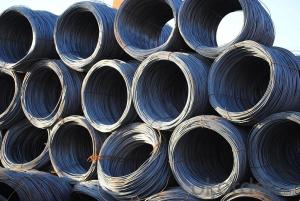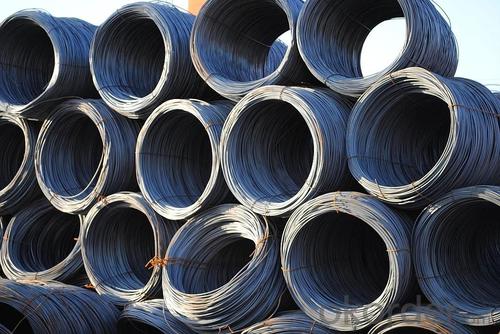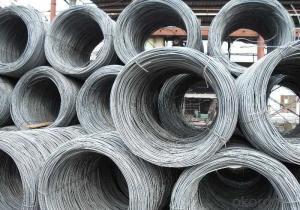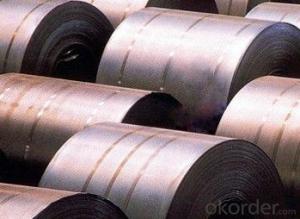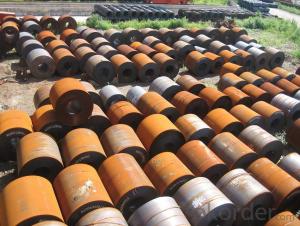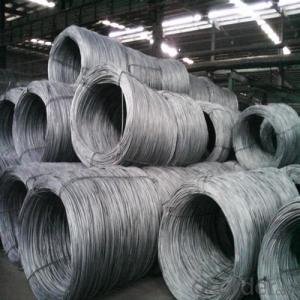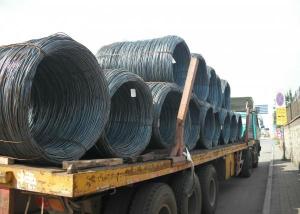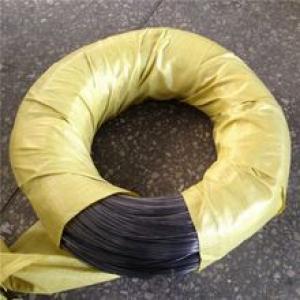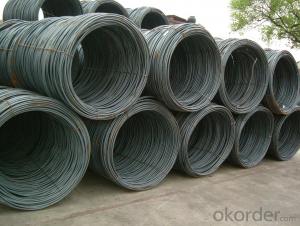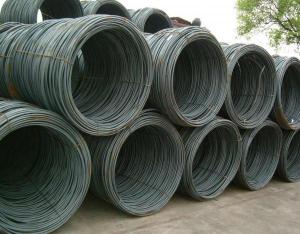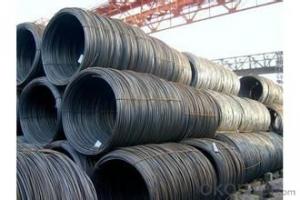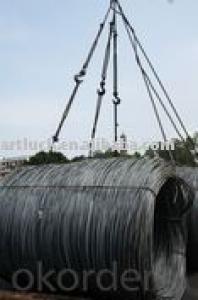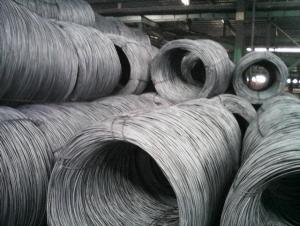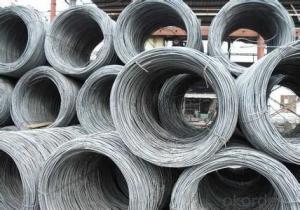Carbon Steel Wire Rod 7mm
- Loading Port:
- China Main Port
- Payment Terms:
- TT OR LC
- Min Order Qty:
- -
- Supply Capability:
- -
OKorder Service Pledge
OKorder Financial Service
You Might Also Like
Specifications of Steel Wire Rod in Coil:
Steel Grade: Q195/235, SAE1006-1018B Standard: ASTM, GB
Diameter: 6.5mm
Type: Drawn Wire Alloy or Not: Alloy Brand Name: HSKY
Technique: Hot Rolled Place of Origin: China Mainland
Chemical Composition:(Please kindly find our chemistry of our material based on SAE1006B and SAE1008B as below for your information)
Grade | Chemical Composition (%) | |||||
C | Mn | S | P | Si | B | |
SAE1006B | 0.03~O.07 | 0.32max | 0.045max | 0.040max | 0.30max | 0.0008min |
Mechanical properties | ||||||
Yield strength(N/mm2) | Tensile strength(N/mm2) | Elongation (%) | ||||
250-280 | 350-380 | ≥32 | ||||
Grade | Chemical Composition (%) | |||||
C | Mn | S | P | Si | B | |
SAE1008B | 0.10max | 0.3~0.50 | 0.050max | 0.040 max | 0.15max | 0.0008 min |
Mechanical properties | ||||||
Yield strength(N/mm2) | Tensile strength(N/mm2) | Elongation (%) | ||||
≥195 | 315-430 | ≥30 | ||||
- Q: How are steel wire rods used in the production of wire coat hangers?
- Steel wire rods are an essential component in the production of wire coat hangers. These rods serve as the primary material for creating the sturdy and durable frame of the hanger. To begin the manufacturing process, the steel wire rods are first carefully selected based on their quality and strength. They are then fed into a wire drawing machine, which pulls the rods through a series of dies to reduce their diameter and increase their length. This process is known as wire drawing and helps to attain the desired thickness and shape for the coat hanger. Once the wire rods have been properly drawn, they are then cut into specific lengths based on the desired size of the hanger. These cut rods are then sent to a bending machine, where they are shaped into the familiar triangular form of a coat hanger. The bending process involves applying precise pressure and force to the wire rods, allowing them to take on the desired shape without losing their structural integrity. After the bending process, the wire coat hangers may undergo additional treatments, such as polishing or coating, to enhance their appearance and protect them from rust or corrosion. These finishing touches contribute to the overall aesthetic appeal and longevity of the hangers. In summary, steel wire rods are used as the main material in the production of wire coat hangers. They undergo a series of processes, including wire drawing and bending, to create the final product. These hangers provide a sturdy and reliable solution for organizing and hanging clothing items while maintaining their shape and durability over time.
- Q: What are the different types of steel wire rod surface cleaning methods after wire drawing?
- After wire drawing, there are various methods available for cleaning the surface of steel wire rod to eliminate any impurities or contaminants. 1. Mechanical Cleaning: This method involves physically eliminating dirt, dust, or other particles from the wire surface using brushes, air blasts, or abrasive materials. It effectively removes larger debris. 2. Chemical Cleaning: Different cleaning agents or solvents are used in this method to dissolve or remove oils, grease, or other contaminants from the wire surface. These agents can be applied through spraying, immersion, or brushing, and rinsing is often necessary to ensure complete removal of residues. 3. Electrolytic Cleaning: By submerging the wire in an electrolyte solution and applying an electric current, this method dissolves and separates surface contaminants. It effectively removes very thin layers of impurities. 4. Pickling: Pickling is a specific type of chemical cleaning that involves immersing the wire in an acid solution to eliminate any oxide layers or scales formed during wire drawing. The acid reacts with the oxides, dissolving them and leaving the wire surface clean for further processing. 5. Ultrasonic Cleaning: High-frequency sound waves create tiny bubbles in a cleaning solution in this method. These bubbles implode near the wire surface, creating a scrubbing action that dislodges and removes contaminants. It is particularly useful for cleaning wire surfaces with complex geometries or hard-to-reach areas. It is crucial to consider the specific requirements of the wire application and the nature of the contaminants when choosing a cleaning method. Each method has its own advantages and limitations, and selecting the most appropriate method is essential to ensure the wire meets the desired cleanliness standards.
- Q: What are the cost considerations of steel wire rod?
- The cost considerations of steel wire rod include the price of raw materials, production and manufacturing costs, transportation expenses, and market demand. Additionally, factors such as quality and specifications can also affect the overall cost.
- Q: What are the different decarburization testing methods for steel wire rod?
- Steel wire rod commonly undergoes various decarburization testing methods to determine the depth and extent of decarburization. These methods play a crucial role in assessing the quality and integrity of the steel wire rod. Below are different approaches utilized for decarburization testing: 1. Macro examination: A visual inspection of the steel wire rod's surface is conducted to identify signs of decarburization. The rod is cut, polished, and observed under a microscope to evaluate the depth and severity of decarburization. 2. Micro examination: Similar to macro examination, micro examination also involves inspecting the steel wire rod's surface under a microscope. This method provides a more detailed and magnified view, enabling a more accurate assessment of decarburization depth and extent. 3. Chemical analysis: By analyzing a sample of the steel wire rod's composition, chemical analysis can determine its carbon content. This data is then compared against desired specifications, with higher carbon content suggesting lower decarburization levels. 4. Hardness testing: Decarburization can affect the hardness of the steel wire rod. Hence, hardness testing measures the rod's resistance to indentation or penetration. A decrease in hardness may indicate the presence of decarburization. 5. Microhardness testing: This method measures the hardness of the steel wire rod using a smaller and more precise indenter. Microhardness testing offers a more accurate measurement of hardness and can detect the presence of decarburization. 6. Metallographic analysis: By preparing, polishing, and examining a sample of the steel wire rod under a microscope, metallographic analysis allows for the observation of the steel's microstructure and the presence of decarburization. Implementing a combination of these decarburization testing methods enables manufacturers to assess decarburization levels accurately. Consequently, appropriate measures can be taken to uphold the desired quality standards.
- Q: How are steel wire rods used in the manufacturing of fishing nets?
- Steel wire rods are used in the manufacturing of fishing nets as they provide the necessary strength and durability required for the nets to withstand the harsh conditions of fishing. These rods are typically used as the framework or support structure of the net, ensuring that it remains intact and can effectively capture fish without breaking or tearing.
- Q: How is steel wire rod used in the production of wire mesh for architectural applications?
- Steel wire rod is commonly used in the production of wire mesh for architectural applications due to its strength and durability. The wire rod is first drawn into the desired diameter and then woven or welded together to form the wire mesh. This mesh is then utilized in various architectural applications such as fencing, partitions, and decorative screens. The steel wire rod provides the necessary structural integrity and stability to the wire mesh, making it a reliable choice for architectural designs.
- Q: How is steel wire rod packaged for transportation?
- Steel wire rod is typically packaged in various ways for transportation, depending on the customer's specific requirements and the chosen mode of transportation. One commonly used packaging method involves creating coils by tightly winding the wire rod around a central core. These coils are convenient to handle and transport, and their size and weight can be adjusted according to the customer's needs and the transportation method. To prevent damage during transportation, the coils are often wrapped in protective materials like plastic or paper. Apart from coils, steel wire rod can also be packaged in bundles. These bundles consist of a certain number of individual rods, securely bound together using straps or wire. This packaging is usually preferred for larger quantities of wire rod as it allows for easier handling and loading onto trucks or shipping containers. Bundles are also wrapped with protective material to ensure safe transportation. For international shipping, containers may be necessary. In such cases, the wire rod can be loaded into containers as either coils or bundles, depending on the customer's preference and the efficiency of loading and unloading at the destination. Overall, the packaging of steel wire rod for transportation prioritizes safe and efficient delivery to the customer. Factors such as the quantity of wire rod, the mode of transportation, and the customer's specific requirements are taken into account. By utilizing coils, bundles, or containers, steel wire rod can be securely packaged, minimizing the risk of damage and ensuring its arrival in the desired condition.
- Q: How is steel wire rod used in the manufacturing of wire for conveyor belts?
- Steel wire rod is the primary raw material used in the manufacturing of wire for conveyor belts. It is drawn into smaller diameters, often through a die, to form individual wires. These wires are then twisted or woven together to create the wire mesh that forms the core structure of the conveyor belt. The strength and durability of steel wire rod make it ideal for withstanding the high tension and heavy loads that conveyor belts often encounter in various industries.
- Q: What are the standard hardness requirements for steel wire rod?
- The standard hardness requirements for steel wire rod are contingent upon various factors, including the intended use and specific industry standards. However, there exist some general principles that can be adhered to. In most instances, the hardness of steel wire rod is gauged using the Rockwell hardness scale. The particular Rockwell hardness (HRC) requirement may differ based on the grade and type of steel wire rod. For instance, low carbon steel wire rod typically falls within the range of 45 to 55 HRC, whereas high carbon steel wire rod may necessitate a hardness requirement of 55 to 65 HRC. Moreover, industry standards like ASTM (American Society for Testing and Materials) or ISO (International Organization for Standardization) may proffer specific hardness requirements for different grades and applications of steel wire rod. These standards guarantee that the wire rod satisfies the requisite mechanical properties for its intended use, encompassing strength, ductility, and wear resistance. It is important to note that the hardness requirements for steel wire rod can also be influenced by customer specifications or specific manufacturing processes. For example, wire rods employed in the production of springs or cables may necessitate more stringent hardness requirements in comparison to those utilized for general applications. Ultimately, it is advisable to consult the pertinent industry standards, customer specifications, or specific product requirements to ascertain the standard hardness requirements for steel wire rod within a given context.
- Q: What are the national standards for steel wire rod?
- The national standards for steel wire rod vary from country to country, as each country has its own set of regulations and requirements for the production and quality control of steel wire rod. These standards typically cover aspects such as chemical composition, mechanical properties, dimensions, tolerance levels, testing methods, and packaging. It is important for manufacturers and suppliers to adhere to these national standards to ensure the safety and reliability of steel wire rod products in their respective markets.
Send your message to us
Carbon Steel Wire Rod 7mm
- Loading Port:
- China Main Port
- Payment Terms:
- TT OR LC
- Min Order Qty:
- -
- Supply Capability:
- -
OKorder Service Pledge
OKorder Financial Service
Similar products
Hot products
Hot Searches
Related keywords
